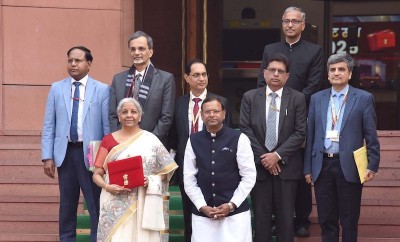
Mukesh Ambani exits Asian Paints with ₹9,080 cr windfall after 17-yr bet: Report
Mumbai: Mukesh Ambani has exited his long-standing investment in Asian Paints, turning an initial ₹500 crore stake into a staggering ₹9,080 crore profit over 17 years, Economic Times reported.
This 2,200% return marks one of the most successful long-term bets in India’s corporate landscape.
Reliance Industries Ltd (RIL), through its subsidiary Siddhant Commercials, sold its remaining 87 lakh equity shares in Asian Paints to ICICI Prudential Life Mutual Fund in a block deal valued at ₹1,876 crore, the company said on Monday. The shares were sold at an average price of ₹2,207.65 each.
This follows last week's ₹7,704 crore sale of 3.5 crore shares to SBI Mutual Fund, marking the full divestment of RIL’s 4.9% stake in the paint major.
Perfect timing amid growing headwinds
The exit comes at a time when Asian Paints is facing its stiffest competitive test in decades.
The company's stock has tumbled over 30% in the last two years, placing it among the worst performers in the blue-chip segment.
Ambani's decision coincides with a significant erosion of Asian Paints' market share — from 59% to 52% in FY25 — according to Elara Securities. The entry of Aditya Birla Group-backed Birla Opus Paints has altered the industry dynamics, weakening the grip Asian Paints once had on the sector.
Profit squeeze despite easing input costs
Muted top-line growth for four straight quarters has further added to the challenges.
The company has blamed factors like tepid urban demand and an early Diwali for the slowdown.
However, despite a fall in raw material prices, Asian Paints has suffered from shrinking margins, driven by increased competition and higher rebates.
Part of RIL’s broader capital strategy
Market watchers view the exit as a well-timed capital redeployment in line with RIL’s shifting strategic focus.
Mayank Maheshwari of Morgan Stanley remarked, “RIL is in its 4th monetisation cycle as its investments in new energy and eventually AI infrastructure start to fructify in F26. By end-2027, we see monetisation of the petrochemical investments as well.”
The firm expects a positive re-rating for RIL, supported by a sustained improvement in return on capital employed (ROCE) beyond 9%.
RIL’s annual capital expenditure, estimated at around $15 billion for the next three years, is seen as manageable given its robust internal cash flows.
A contrarian call that paid off
Back in January 2008, as markets reeled from the global financial crisis and the collapse of Lehman Brothers, RIL took a contrarian call by acquiring a 4.9% stake in Asian Paints for ₹500 crore.
The foresight has now yielded one of the most lucrative exits in the company’s investment history.
Support Our Journalism
We cannot do without you.. your contribution supports unbiased journalism
IBNS is not driven by any ism- not wokeism, not racism, not skewed secularism, not hyper right-wing or left liberal ideals, nor by any hardline religious beliefs or hyper nationalism. We want to serve you good old objective news, as they are. We do not judge or preach. We let people decide for themselves. We only try to present factual and well-sourced news.







